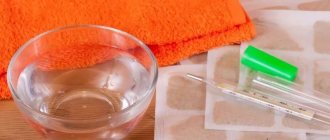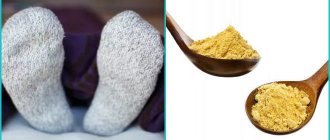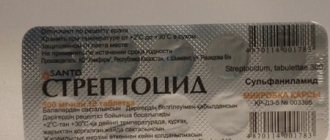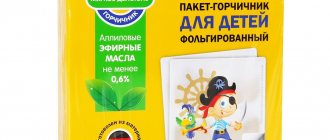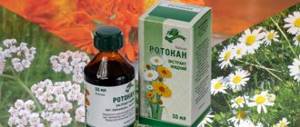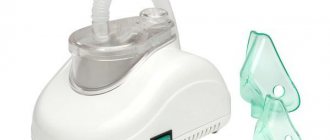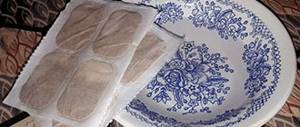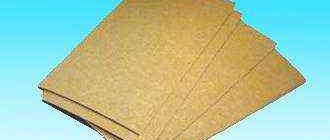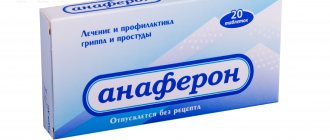Water temperature for setting mustard plasters
Penetrating into the patient's skin, the essential oil that is part of mustard irritates it and dilates the skin blood vessels and reflexively causes dilation of the blood vessels of the internal organs.
Places for placing mustard plasters: chest area (excluding areas with bony protrusions and mammary glands), collar area, heart area, calf muscles.
Indications: 1) acute inflammatory diseases of the upper respiratory tract and lungs. 2) muscle inflammation (myositis); 3) neuralgia, neuritis; 4) hypertensive crisis; 5) pain in the heart (angina attack); 6) osteochondrosis.
Contraindications: 1) bleeding; 2) skin diseases; 4) tumors of various etiologies; 5) allergic reactions to essential oils; 6) violation of the integrity of the skin; 7) hyperemia.
Workplace equipment: 1) mustard plasters; 2) tray with water t=40-45 o C; 3) tray for waste material; 4) napkin or towel; 5) water thermometer; 6) watch; 7) gauze napkins.
Preparatory stage of performing the manipulation.
1. Explain to the patient about the need for nursing intervention and provide complete information about the procedure.
2. Obtain consent.
3. Prepare all necessary equipment.
4. Check the quality of mustard plasters and expiration date.
5. Examine the patient’s skin and make sure that there are no contraindications for applying mustard plasters.
6. Help the patient take a comfortable position.
7. Measure the temperature of the water for wetting the mustard plasters.
8. Wash and dry your hands.
The main stage of the manipulation.
9. Soak mustard plasters in water for 5 seconds each, shake off and apply to the desired area of skin with the mustard facing down.
10. Place a towel or napkin on top.
11. Cover the patient with a blanket, look after 5 minutes and rule out signs of individual intolerance.
12. Keep mustard plasters for 10 – 15 minutes.
The final stage of the manipulation.
13. Remove the mustard plasters and throw them into the waste tray.
14. Use a gauze cloth soaked in warm water to wipe the patient’s skin, remove any remaining mustard and dry the skin.
15. Cover with a blanket and invite the patient to lie in bed for at least 30 - 40 minutes.
16. Wash your hands and dry with a towel.
WARMING COMPRESS FOR THE EAR
Indications. Acute otitis media.
Contraindications. Fever with a body temperature of 38 °C and above, purulent otitis media, inflammation of the mastoid process, purulent processes of the external ear, pyoderma and eczematous skin lesions of the parotid area.
General information. A warming compress causes a long-term and uniform dilation of blood vessels, which helps resolve the inflammatory process and reduce pain.
The compress consists of three layers: inner (wet), middle (insulating) and outer (warming). Each subsequent layer should be 2 cm wider than the previous one. For compresses, camphor (vegetable) oil and ethyl alcohol solution
(in children under three years old - 20-25%, in older ones - 45%), as well as
an oil-alcohol solution
in a 1:1 ratio.
Water for diluting alcohol and oil are preheated to a temperature of 38-39 ° C. The oil compress is applied for 6-8 hours, most often at night. If it is necessary to repeat the procedure, take a break for 1-2 hours and apply the compress again. When changing it, the inner layer should be changed, since microorganisms can actively multiply in a humid and warm environment.
Workplace equipment: 1) camphor oil (vegetable), ethyl alcohol; 2) a container with warm water to heat the oil; 3) thermometer; 4) a napkin made of 6-8 layers of gauze; 5) wax paper (compress oilcloth); 6) cotton wool; 7) bandage; equipment tray; 9) a tray for used equipment; 10) containers with disinfectant for disinfecting surfaces and used equipment.
2) a container with warm water to heat the oil; 3) thermometer; 4) a napkin made of 6-8 layers of gauze; 5) wax paper (compress oilcloth); 6) cotton wool; 7) bandage; equipment tray; 9) a tray for used equipment; 10) containers with disinfectant for disinfecting surfaces and used equipment.
Preparatory stage of performing the manipulation. 1. Inform the patient (close relatives) about the need to perform and the essence of the manipulation.
2. Obtain the consent of the patient (close relatives) to perform the manipulation.
3. Wash and dry your hands. Wear gloves.
4. Treat the trays, instrument table, changing mattress with a disinfectant solution (when performing manipulations on the changing mattress). Remove gloves. Wash and dry your hands.
5. Place the necessary equipment on the tool table.
6. Prepare three layers of compress, commensurate with the child’s parotid area. For the wet layer, take a gauze napkin, for the insulating layer - wax paper (compress oilcloth), for the insulating layer - cotton wool 2-3 cm thick.
7. In the wet and insulating layers, make a midline incision corresponding to the size of the ear.
8. Heat the oil (water for diluting alcohol) to a temperature of 38-39 °C.
The main stage of the manipulation. 9. Lay the child on his side so that the sore ear is on top. For children who can sit, the compress is applied in a sitting position.
10. Soak a gauze pad in oil (ethyl alcohol solution), squeeze it out and apply to the skin around the ear. Then put wax paper. Bring the auricle out through the moist and insulating layers. Place cotton wool on top.
11. Secure all layers of the compress with a bandage. It is prohibited to carry out rounds of the bandage under the chin. For better fixation, they are carried out alternately in front and behind the healthy ear, leaving it open.
12. Periodically monitor the correct placement of the compress. To do this, carefully, without disturbing the tightness of the bandage, move your index finger under the wet layer. When the manipulation is performed correctly, the skin and gauze should be warm and moist.
Source: https://sustavo.ru/info/temperatura-vody-dlja-postanovki-gorchichnikov/
Places for placing mustard plasters:
- to the chest area
- upper shoulder girdle
- heart area
- on your feet
- Preparation for the procedure:
| 1. | Introduce yourself to the patient, explain the process and purpose of the procedure, and obtain the patient’s consent. |
| 2. | Make sure you are not allergic to mustard. If you have an allergy, consult a doctor. |
| 3. | Treat your hands in a hygienic manner. |
| 4. | Check the suitability of mustard plasters: mustard should not fall off the paper and have a specific (pungent) smell. When using mustard plasters made using other technologies (for example, packaged mustard), check the expiration date. |
| 5. | Pour warm (40-45°) water into the tray. |
| 6. | Help the patient lie on his stomach (when placing mustard plasters on his back) and take a comfortable position, the patient's head should be turned to the side. Expose the place where the mustard plasters were placed. |
| 7. | Choose a place to place mustard plasters. |
| 8. | Examine the skin for damage, pustules, and rashes. |
- Performing the procedure:
| 9 | Immerse mustard plaster in warm water for at least 3 seconds, shake off excess water |
| 10. | Press the mustard plaster firmly onto the skin with the side covered with mustard or the side on the tissue paper. |
| 11. | Repeat pp. 9-10, placing the required number of mustard plasters on the skin. |
| 12. | Cover the patient with a diaper, then a blanket. |
| 13. | Clarify the patient’s sensations and the degree of hyperemia after 3-5 minutes. |
| 14. | Leave the mustard plasters for 10-15 minutes, taking into account the patient’s individual sensitivity to mustard. Observe the patient during the procedure. |
- End of the procedure:
| 15. | If persistent hyperemia or an unbearable burning sensation appears (after 10-15 minutes), remove the mustard plasters and place them in a tray for used materials. |
| 16. | Soak a napkin in warm water and remove any remaining mustard from the skin. If necessary, performed by junior medical staff |
| 17. | Use a diaper to blot the patient's skin dry. Help him put on his underwear, cover him with a blanket and warn him to stay in bed for at least another 20-30 minutes and not take a bath or shower that day. |
| 18. | Treat your hands in a hygienic manner. |
| 19. | Make an appropriate entry about the procedure performed in the medical documentation. |
Additional information about the features of the technique:
For infants, spread a blanket, a diaper, a diaper, and another diaper on top, folded in several layers. Unwrap (undress) the baby and place him on the prepared diapers. Place mustard plasters in a “tile” pattern between the first and second layers of diaper, mustard side down. Place the mustard plasters so that they leave the spine and heart area free, wrap the diaper with mustard plasters around the chest.
It is necessary to monitor the time of the procedure, since with longer exposure to mustard plasters, skin burns are possible.
The placement of mustard plasters depends on the indications:
- for respiratory diseases - on the back and lateral surfaces of the chest;
- for angina pectoris - on the heart area;
Placement of mustard plasters: algorithm, indications, contraindications, duration
› Health › Don’t get sick
One of the main nightmares of our childhood is mustard plasters! How we resisted our mother’s desire to cure us in such a barbaric way! Now, having become parents ourselves, we understand the importance and necessity of such a procedure.
But careless use of this ancient remedy can end very disastrously.
It is necessary to know and fully follow the correct algorithm in order for the installation of mustard plasters to really help cope with the disease.
Mustard plasters are the number 1 remedy for colds
Why are mustard plasters needed and how do they work?
The main purpose of mustard plasters is to force the body to heal itself. The action is based on a rush of blood to problem areas, as a result of which pain symptoms are relieved and inflammatory processes are damped. The work algorithm is based on the physiology of the human body:
- blood vessels dilate under the influence of an external stimulus;
- blood circulation increases;
- in parallel, the excitability of the sympathetic nervous system increases, which gives an influx of adrenaline into the blood;
- adrenaline enhances the phagocytic reaction - the main factor of immunity in the fight against infections and inflammation.
Using mustard plasters, we force our body to react faster to the disease, boost the immune system and bring recovery closer, using only internal strength. Therefore, it is extremely important to carry out the procedure correctly, taking into account the indications and only in the absence of other strong stresses (high temperature, especially in children; external and internal bleeding, etc.).
Indications for placing mustard plasters:
- respiratory diseases;
- headache;
- heart pain (distracting effect in the chest area);
- high blood pressure;
- muscle pain.
Indications for use of the drug include cough, headache, sprains, and bruises. It is important to remember that mustard plasters must be used strictly for their intended purpose. Attempts to fight cellulite with their help (there are such bad tips!) can end tragically not only for cellulite, but also for health.
In our country, the drug is available in two forms:
- a thick sheet of paper (8 x 12.5 cm) coated with a mixture of mustard cake and seeds;
- paper bags of 3 g each, in which the mustard mixture is divided into 4 sections by gluing seams.
Mustard plasters are available in the form of sheets and bags
Before use, be sure to check the expiration date of the drug. Expired mustard plasters change color, and the mustard mixture may dry out and crumble.
Contraindications for use
The first thing you should be interested in in any drug is contraindications. This rule also applies to mustard plasters. So, contraindications for staging:
- Age. Children can only undergo the procedure from the age of six!
- Heat. For adults – above 38°C, for children – above 37°C. In the acute phase of the disease, the use of warming procedures is contraindicated; you should wait until the patient’s condition improves and the temperature decreases.
- Any bleeding. External wounds or internal bleeding weaken the body; placing mustard plasters in such a situation can be harmful.
- Some diseases: malignant tumors, active form of tuberculosis, asthma, blood diseases.
- Problems or damage to the skin (neurodermatitis, psoriasis, eczema), moles or birthmarks at the intended location.
- Skin sensitivity or allergy to mustard.
- During pregnancy, mustard plasters can only be used with the permission of a doctor!
High temperature is a contraindication to the use of mustard plasters
It is dangerous not to pay attention to any of the listed contraindications. Instead of the expected relief, this can cause serious harm to the patient. In addition, mustard plasters should not be placed on the mammary glands or face. For children, it is best to conduct the session in the evening, so that before going to bed there is time to cough up the mucus that comes out.
Sequencing
The algorithm of actions is quite simple. Before you start, make sure you have:
- fresh mustard plasters in the right quantity;
- warm water up to 40°C (water temperature above 45°C destroys mustard essential oils - the main irritants, negating the entire therapeutic effect);
- a towel, gauze wipes, a thin diaper for babies and heated vegetable oil (to prevent burns).
To begin with, the patient must be comfortably positioned in such a way that the part of the body on which the placement will be performed according to the indications is open. Then we act, strictly adhering to the algorithm.
Technique for setting mustard plasters:
- After completion, the area should be wiped clean of mustard residues (for children, remove any remaining oil). This is done with a clean napkin soaked in warm water, with careful movements, trying not to press too hard on the insertion sites (to avoid unpleasant sensations).
- If the patient is in normal condition, the duration of the session is up to 15 minutes. But after 5-10 minutes. there will be an effect, so you shouldn’t mock the patient too much and force him to withstand the entire 15 minutes.
- This point is very important! Allow time (3-5 minutes) and check the patient. If you experience a strong burning sensation, you need to check the area for redness. If hyperemia occurs (overflow of blood vessels, expressed in redness of the skin area), stop the session immediately. You need to listen especially carefully to children. They cannot always explain what is bothering them; they should check the placement sites regularly (perhaps even before 3 minutes if the child is restless).
- Cover the installation site with clean paper or film and wrap it with a towel on top. This is necessary so that the mustard mixture warms up to 39-45°C; it is at this temperature that the release of essential oil begins.
- Apply the prepared sheet with the side covered with the composition to the body in a predetermined place (see diagram of indications and location of mustard plasters).
- Dip the mustard plaster into a container of water for 1-3 seconds. If the drug is made in the form of a paper bag, it must be shaken before immersing in water so that the powder is evenly distributed throughout the cells.
- Carefully examine the patient for damage, scratches, wounds or moles at the site of intended placement. For young children, it would be a good idea to lubricate the placement area with heated vegetable oil to prevent burns.
- Gently wipe the place of placement, help the person lie down more comfortably and leave him to rest for 30-40 minutes. The thermal procedure puts a lot of stress on the body, so you need time to recuperate (at least 20 minutes, but 40 is better).
If the exposure time is not calculated, redness or burns may occur. They should be washed carefully and lubricated with emollient cream. In order to reduce the risk of burns, people with sensitive skin and children can place mustard plasters on gauze folded in half and moistened with warm water.
“You need to know the places”
Knowing the staging algorithm is not the only rule for a quick recovery. It is important to know where mustard plasters are placed. The scope and quantity depend on the disease:
- For various respiratory diseases (bronchitis, pleurisy, colds, pneumonia) you will need 5-8 pcs. They are placed on their backs, avoiding the heart area.
- At the very beginning of a cold (if there is no high temperature) you can put it on the soles of your feet.
- Migraine (with hypertension) will be relieved by warmth in the back of the head.
- For neuralgia, myositis, sprains - directly on the painful area.
- In case of angina pectoris, the warming procedure performs a distracting function. In this case, mustard plasters are placed on the chest in the area of the heart.
For various diseases, mustard plasters need to be placed in certain places
Along with mustard plasters, jars are often used for coughs or colds. Whether this action makes sense for adults is a moot point. In addition, the algorithm for placing cans is not so simple. Children should definitely not use such treatment.
The famous children's doctor Komarovsky claims that modern medicine is categorically against the use of cups for children, especially children of preschool or early school age.
Such a barbaric operation grossly disrupts blood circulation in the skin and subcutaneous layer and can cause irreversible damage to blood vessels or cause bleeding.
In addition, cups should never be used by children or adults for any damage to the skin, at elevated temperatures, or when taking medications that reduce blood clotting (banal aspirin). Instead, it is better to use warm compresses or wraps.
The human body has a huge margin of safety and is quite capable of coping with colds on its own. Mustard plasters, compresses or wraps, given in accordance with the indications, will only boost the immune system and slightly speed up recovery.
An ancient remedy in modern medicine: the correct algorithm for placing mustard plasters Link to the main publication
Source: https://LadyKrasotka.com/health/neboleem/postanovka-gorchichnikov-algoritm.html
Placement of mustard plasters mechanism of action indications contraindications
Mustard plasters The active ingredient of mustard plasters is essential mustard oil, which is part of mustard and is released from it at a temperature of 40-45 ° C. The oil causes irritation of the skin receptors and its hyperemia, leads to the expansion of blood vessels located deeper than the internal organs, due to which an analgesic effect is achieved, and the resorption of some inflammatory processes is accelerated.
Mustard plasters are used in the treatment of colds, inflammatory diseases of the upper respiratory tract (rhinitis, pharyngitis), inflammatory processes in the lungs (bronchitis, pneumonia), neurological diseases (myositis, neuralgia), and angina pectoris and hypertensive crisis. Standard mustard plasters are sheets of thick paper 8 x 12.5 cm, covered with a layer of low-fat mustard powder (shelf life is 8-10 months), or bags of compressed filter paper, between the layers of which there is mustard powder. Suitable mustard plaster has a pungent smell of mustard oil and does not crumble. These qualities must be checked before using it. Before use, mustard plaster is moistened in warm water (40-45 °C). At higher temperatures, mustard oil is destroyed. Mustard plasters are applied for 10-15 minutes; in this case, the patient should feel warmth and a slight burning sensation, and the skin should become hyperemic (reddened). Longer exposure to mustard plasters may result in skin burns.
Places for placing mustard plasters:
- Back of the head (acute rhinitis, hypertensive crisis)
- Upper part of the sternum (acute tracheitis)
- Interscapular area and under the shoulder blades (bronchitis, pneumonia).
— Calf muscles (effective for acute inflammation of the upper respiratory tract).
Mustard plasters can only be placed on intact skin. Mustard plasters should be avoided on the mammary glands, nipple area, spine, and birthmarks. Indications
for the placement of mustard plasters: inflammatory diseases of the upper respiratory tract (rhinitis, pharyngitis), inflammatory processes in the lungs (bronchitis, pneumonia), myositis, neuralgia, hypertensive crisis (on the back of the head).
Contraindications
before the procedure: skin diseases (pyoderma, neurodermatitis, eczema), high fever (above 38 ° C), pulmonary hemorrhage or the likelihood of its development, malignant neoplasms.
Required equipment:
warm water (40-45 °C), tray, mustard plasters, towel, flannel diaper, blanket.
Algorithm for performing the procedure: 1. Prepare warm water. 2. Place the patient in a position comfortable for him and carefully examine the skin. 3. Immerse the mustard plaster for 5-10 seconds in warm water at a temperature no higher than 45 °C. 4. Apply mustard plaster with the side covered with mustard to the skin (if the skin is hypersensitive, mustard plaster is applied through gauze). 5. Cover the area where mustard plasters are placed with a towel, then a blanket. 6. After 5-10 minutes from the moment the burning sensation appears, remove the mustard plasters from the skin with a damp cloth. 7. Remove any remaining mustard powder by carefully wiping the skin with a cloth soaked in warm water. 8. Wipe the skin dry and cover the patient with a blanket.
Warmer. Indications. Contraindications. Equipment. Action algorithm
A heating pad is a dry thermal procedure; it has a local warming effect. The heating pad is used as an analgesic and antispasmodic. With frequent and prolonged use of a heating pad, the patient’s skin is pre-lubricated with Vaseline to prevent burns and hyperpigmentation. Indications:
inflammatory infiltrates, neuritis, neuralgia.
Contraindications:
acute abdominal pain of unknown origin, acute processes in the abdominal cavity (appendicitis, pancreatitis, cholecystitis, etc.), malignant neoplasms, the first day after injury, bleeding, infected wound, damage to the skin, unconsciousness. Warmers come in capacities from 1 to 3 liters.
There are several options for heating pads:
— Rubber (water).
— Electrothermal (works from the mains);
- Chemical.
Necessary equipment: rubber heating pad, hot water (about 50 °C), towel. Algorithm for performing the procedure:
1. Fill the heating pad 2/3 full with hot water.
2. Carefully force the air out of the heating pad by squeezing it with your hands towards the neck.
3. Close the heating pad tightly with the stopper (lid).
4. Check the heating pad for leaks by turning it over.
5.Wrap the heating pad in a towel and apply to the appropriate area of the body.
Using an ice pack. Therapeutic effect. Indications. Equipment. Algorithm for performing the procedure Possible complications.
An ice pack is used for longer local cooling. It is a flat rubber bag with a wide opening and a lid, which is filled with pieces of ice before use.
Indications: first hours after injury, internal bleeding, second period of fever, initial stage of some acute abdominal diseases, bruises. Contraindications: cramping abdominal pain, collapse, shock. Necessary equipment: ice, ice pack, towel (sterile oilcloth).
How to place mustard plasters: how correctly and often, how long to keep on the chest
It is generally accepted that mustard plasters are one of the most effective means of fighting cough. Their price is incomparable with modern popular pharmaceutical drugs against colds, which makes them more accessible to all people.
Almost all children who grew up in Soviet and post-Soviet times felt their effects at least once in their lives. Recently, these patches have not lost any of their leadership positions in the fight against cough. The effect of them is usually described as something burning and “burning”, so it is forbidden to place them at an elevated body temperature; it should reach no more than 37 degrees.
But how to install mustard plasters correctly and what recommendations must be followed? Let's look at these and other questions in more detail in our article.
- Where exactly should you put mustard plasters and how often?
- Basic tips and tricks
Instructions for use
Installing mustard plasters takes little time. Most people think that this procedure will take at least an hour, but in practice it will take no more than 20 minutes. There is a common myth that the type of cough determines how to place the mustard plaster.
In fact, mustard plasters should be used equally for both wet and dry coughs. They can also be used as an anti-inflammatory agent for pneumonia; before the procedure, you should consult your doctor.
They can cope with both headaches and pain in the heart.
How to install mustard plasters correctly
In order for mustard plasters to have their therapeutic effect, they must be placed in accordance with the instructions. It is necessary to prepare the following elements for the procedure:
- mustard patches,
- container with water at optimal temperature – approximately 43°C,
- towel,
- baby cream or any vegetable oil,
- cover.
The package of mustard sachets purchased at the pharmacy must be unpacked, then dipped in a dish of warm water for about 10 seconds, and then immediately applied to the patient’s skin. A towel is placed over the patches, and the person must be carefully wrapped in a blanket, bedspread or rug.
There are certain recommendations for the time during which the bags should be kept on the body: from 5 to 15 minutes, depending on the form of the disease. For a dry cough, the applied patch should be kept on for at least 10 minutes, but no more than 25 minutes. The used patch cannot be reused.
If the patient cannot at all tolerate the “burning” effect of the product, then it is recommended to remove the patches, since individual intolerance is possible. But allergies can easily be confused with ordinary panic that has arisen in the patient, so for those who are not allergic to mustard plasters, but cannot tolerate the effect of the drug, you can put gauze between the skin and the patches.
After the procedure has expired, the cards should be removed and the body of the child or adult should be carefully wiped with a clean towel, and then the skin should be moistened using vegetable oil and the patient should be wrapped in a blanket again.
The sequence of how to place mustard plasters for bronchitis is no different from placing them for pneumonia. The patches should be placed either between the shoulder blades or on the chest, avoiding the heart area.
Where exactly should you put mustard plasters and how often?
Before starting treatment with mustard plasters, you need to make sure that the area on which the bags will be applied is clean and free of wounds, cuts and other skin defects.
So, how and where to place cards correctly? For colds, this remedy is placed either on the chest, or on the upper back, or in the area between or under the shoulder blades. But sometimes the patch is attached to the soles of the feet or calves. You must wear socks over the cards.
It is recommended to apply patches on the back if you have respiratory diseases. If you have a sore throat, apply mustard plasters to your chest. For high blood pressure they are used on the calves, and for headaches - on the back of the neck. Therefore, the answer to the question of where to put mustard plasters depends directly on the disease that the person suffers from.
How often can mustard plasters be installed? It is highly not recommended to use them constantly. The maximum number of uses of these sachets is 4 days, that is, if the patient has a severe cough, then mustard plasters are applied every day for 4 days once a day.
If health improvement does not occur on the first day after the procedure, then the use of this treatment method should be suspended. It is possible that this kind of therapeutic measures will not have an effect on a person due to the individual characteristics of the body, or the disease has already reached a more serious stage.
It is necessary to control how many times mustard plasters were placed, since excessive enthusiasm for this self-medication can lead to side effects in the form of allergies.
Basic tips and tricks
Usually mustard plasters are given to children when signs of a cold appear, but people often have the question: “Can mustard plasters be given to adults?” The answer, of course, is unequivocal - “yes”. In adults, migraines may appear, blood pressure may rise, and a cough may occur, which mustard plasters can easily cope with.
Why use such products if at the moment you can buy a lot of tablets and syrups at the pharmacy, the use of which does not require time? Mustard plasters are made using natural ingredients and have gained popularity due to their truly effective results.
Modern drugs can be addictive, and their prices reach high levels. The procedure time for an adult is 10-15 minutes; if an unbearable burning sensation occurs, the bags should be removed and the patient’s skin should be treated with warm water, then lubricated with baby cream.
It must be remembered that putting mustard plasters on the chest, back and other parts of the body is strictly prohibited in the presence of an acute respiratory infection.
Its hallmarks are elevated body temperature, poor health and chills.
We talked above about when mustard plasters can be used, but there is a list of diseases for which they are strictly contraindicated:
- neurodermatitis,
- asthma,
- psoriasis,
- weeping eczema.
It should also not be used during pregnancy, breastfeeding or in the presence of tumors.
Thus, the question of how to install mustard plasters has been discussed in detail. During the procedure, you need to carefully monitor the patient's sympathy. There is no doubt about the effectiveness of the therapy method.
Loading…
Source: https://prof-medstail.ru/bolezni-legkih/preparaty/gorchichniki-pokazaniya-k-primeneniyu
Installation of mustard plasters
INDICATIONS: As prescribed by a doctor (for colds of the respiratory system, high blood pressure, pain in the heart).
CONTRAINDICATIONS: High fever, diseases and damage to the skin in this area, increased sensitivity of the skin, bleeding, ulcers, etc.
EFFECT ON THE BODY: irritation of skin receptors, reflex expansion of blood vessels of internal organs, increased blood flow to the corresponding area of the skin and tissues.
THERAPEUTIC EFFECT : distracting, analgesic, anti-inflammatory, absorbable.
LOCATIONS FOR INSTALLING MUSTARD PASTERS : On the chest in front and behind, on the heart area, on the back of the head, on the calf muscles, on the desired area (as prescribed by the doctor).
SAFETY RULES WHEN INSTALLING MUSTARD POSTS.
- When applying mustard plasters, make sure that essential oils do not irritate the patient’s eyes; ask the patient to close his eyes and turn his head to the side.
- Strictly adhere to the time of placing mustard plasters to avoid complications. (no more than 10 min.)
- Monitor the patient's condition during the procedure.
EQUIPMENT: Mustard plasters, tray: with water (t 40-45⁰С), water thermometer, towel, napkin, watch.
PREPARATION OF THE PATIENT.
- Inform the patient about the prescribed procedure.
- Clarify the patient's understanding of the upcoming procedure and obtain consent.
SEQUENCING
- Check for drafts in the room.
- Check the suitability of mustard plasters: mustard should not fall off the paper and have a specific smell. When using packaged mustard plasters, this point is excluded.
- Pour warm water at a temperature of 40-45⁰C into the tray.
- Place the patient in a comfortable position and expose the desired area of the body.
- Immerse the mustard plaster in water for a few seconds, remove it from the water, and shake lightly.
- Place the side covered with mustard powder tightly against the skin and cover with a towel and blanket.
- After a few minutes, ask the patient about his sensation (the patient should feel warmth and a slight burning sensation), lift the corner of the mustard plaster and see the degree of skin hyperemia (in case of severe skin hyperemia, remove the mustard plasters).
- Leave the mustard plasters for 5-10 minutes, taking into account the patient’s individual sensitivity to mustard.
- Remove the mustard plasters and place them in a waste tray.
- Moisten a napkin with warm water and wipe the skin (remove any remaining mustard from the skin), and then wipe dry with a towel.
- Help the patient put on underwear, create a comfortable position, and cover with a blanket.
- Invite the patient to rest for at least 30 minutes. There is no need to take a bath or shower on this day.
- Wash hands, dry.
- Make a note of the completed procedure.
COMPLICATIONS: with prolonged exposure to mustard plasters, skin burns with the formation of blisters are possible.
See also:
| Determination of daily water balance 29.01.2013 Daily water balance is the ratio between the liquid you drink per day and the amount of urine excreted per day. The liquid you drink includes liquid dishes (soup, jelly, borscht, tea, compote, etc.), as well as liquid introduced into the body intravenously or intravenously. The daily water balance (amount of urine) is measured by collecting it in a separate container, which is located in the toilet room, always with a label indicating the room number, the patient’s name and his… |
| Rules for collecting urine for microflora 29.01.2013 EQUIPMENT: sterile containers obtained from the tank. laboratories, sterile physical solution; everything necessary for toileting the external genitalia. PREPARATION OF THE PATIENT: psychological, right to information (purpose and process), obtaining consent. CONDITIONS FOR COLLECTION: collect urine before the start of antibacterial therapy or 3 days after the end; The sampling is carried out after a thorough toilet of the external genitalia and... |
| Priority problems of patients. Urinary incontinence 29.01.2013 Goals: Short-term: a) by the end of the week, the patient realizes that with appropriate treatment this distressing phenomenon will decrease or go away. b) by the end of the week, the patient realizes that with appropriate organization of care, this phenomenon will not create discomfort for others. Long-term: the patient will be psychologically prepared for life in the family at the time of discharge. Nature of Nursing Intervention: M/N will provide isolation... |
How to install mustard plasters for children and adults
putting mustard plasters on children Good afternoon, dear blog readers! Despite the abundance of medications that can quickly and effectively help in the recovery of sick people, mustard plasters are in the medicine cabinet of many mature people. Do young people know how to install mustard plasters and for what purpose are they used in traditional medicine? Of course, many people know, because rarely did anyone in their childhood not try this means of warming up on themselves during illness.
Just think about how many benefits and advantages this simple procedure has compared to synthetic cough syrups and tablets. After all, they are used only externally, and do not irritate the mucous membranes of the stomach and intestines with their effects, and do not give side effects. Unless used wisely, you can slightly set your skin on fire. But it all depends only on yourself.
Their use is convenient and effective and is within the power of every person, and it is important that they quickly give a positive effect.
Installation technique or how to correctly install mustard plasters
Mustard plasters, familiar from childhood, require, like all procedures, certain knowledge. How to install mustard plasters correctly? For this product to be beneficial, you need to prepare the following materials:
- mustard plasters,
- warm water
- a piece of soft cloth or gauze,
- towel,
- blanket.
how to put mustard plasters correctly
If you are putting mustard plasters on a child, the gauze should be folded into 2 layers, moistened with warm water and placed on the skin. Moistened mustard plasters are placed on top of the gauze. Cover the top with a towel so as not to contaminate the blanket and wrap it up warm.
How long should you keep mustard plasters?
It is necessary to set an alarm clock or timer for 5 minutes for children. Be sure to check how red the skin is. If the child tolerates the procedure calmly, you can extend the time by another 5 minutes.
For adults, the procedure lasts up to 20 minutes.
After the warming procedure, it is recommended to lie under a blanket for 30 minutes for both adults and children. Relief occurs after 3-4 days. Pain in the chest and throat is relieved, coughing becomes rare. If the procedures do not bring results, consult a doctor.
Watch the video from which you will learn the answer to the question: To install or not to install mustard plasters?
How to replace mustard plasters?
Mustard baths. All people with coughs and bronchitis will benefit from foot baths with mustard. To do this, fill a basin with hot water (45 degrees), add 3 tablespoons of mustard to it and lower your feet into the basin. Keep them in the water until it cools down. Then wipe dry and put on warm socks. It is better to take the procedure before going to bed, immediately go to bed, under a warm blanket.
Mustard socks.
In their action, mustard socks are identical to mustard plasters, but there is still a difference. Mustard plasters quickly heat up the skin and burn strongly; if held for a long time, a burn may appear on the skin.
The dry powder is poured into cotton socks and it acts slowly, gradually warming the feet and, through reflex points located on the foot, activating the work of all organs and systems.
Mustard socks are used at the first symptoms of a cold; during this period, warming is much more effective. If you have an advanced cold, it is better not to use this procedure.
Mustard socks can be used for treatment by both children and adults. You just need to comply with some conditions:
- for a child when treating with mustard powder, pour 0.5 - 1 teaspoon into socks:
- for an adult - 1 - 2 tablespoons (depending on the size of the foot).
Wash your feet, wipe dry with a dry towel and dry. Do not allow the mustard to get wet, otherwise it will cause a burn. Wool socks are put on top of cotton socks. The procedure is repeated for several days in a row at night. In the morning, wash your feet with warm water.
mustard socks
How to put mustard cake
The question often arises: how to replace mustard plasters in their absence? In this case, a mustard flatbread will help out.
Mustard flatbread is made from a mixture of mustard powder (2 tbsp) and wheat flour (4 tbsp), mixed with lukewarm water. Gradually pour water into the mixture, stirring until it reaches the consistency of sour cream. So that the mass is well spread on the prepared clean cloth. Spread one half of the fabric with mustard mixture, and cover it with the other end.
The result was a mustard flatbread. If you give it to children, then place an additional damp cloth between the skin and the cake, since the cake burns more strongly than mustard plasters bought at the pharmacy. Don't forget to cover the patient warmly to encourage sweating.
For children, the procedure time is no more than 10 minutes, for adults - up to 20 minutes. After removing the compress, wipe the skin with a warm cloth, lubricate with cream and wrap warmly. The procedure is carried out every other day.
What to do if there is a burn?
A burn from mustard plasters may occur if the duration of the procedure is violated. Don’t try to put mustard plasters on yourself; often, when warming up under the blanket, people fall asleep and lose track of time. It is important that someone close to you is with you and monitors the time of the procedure.
how to treat a burn
Important: Never treat burns with alcohol, you will further damage the skin.
Please note this algorithm:
- rinse the skin with water and light touches to maintain its integrity;
- blot with a sterile bandage to remove moisture;
- apply antiseptic ointment (panthenol or furacilin) to the wounds;
- Apply a sterile bandage on top to protect against infection;
- change the bandage twice a day.
Important: Burns from mustard are often accompanied by allergic reactions. If this happens, take an antihistamine tablet.
What diseases are treated for and where mustard plasters are placed?
The procedure, which has a warming and locally irritating effect on the skin, is used to treat adults and children.
for what diseases and where to put
Mustard plasters are used for respiratory diseases:
- for laryngitis, pharyngitis and laryngotracheitis,
- tracheitis and bronchitis,
- pneumonia and bronchopneumonia,
- bronchial asthma and pleurisy.
They bring relief from diseases of the musculoskeletal system:
- for soft tissue bruises and myositis,
- radiculitis and osteochondrosis.
For vasodilation, pain relief, as a distraction and antispasmodic, they are used to treat:
- headaches and neuralgia,
- angina pectoris and hypertension.
Look at the table for which diseases and where mustard plasters should be placed:
| Colds of the upper respiratory tract: acute rhinitis, pharyngitis | Back of the neck, calf muscles, soles of the feet. |
| Acute tracheitis | Upper sternum area |
| Lung diseases: bronchitis, pneumonia | Lung area on the front, back and sides of the chest. |
| Angina attack | Heart area |
| Hypertensive crisis and headaches caused by high blood pressure | Back of the head (back of the neck), soles of the feet. calf muscle area |
| Myositis | Area of affected muscles |
| Neuralgia | Area of affected nerves |
Precautions and contraindications
This is important: During the procedure, take precautions and consider contraindications:
Mustard plasters should not be placed on the heart area, except for angina attacks. Mustard plasters should not be placed on the mammary glands, nipples, or spine.
They are not placed on the shoulder blades either, since the shoulder blade bones block the impact on the organs located under them. And there will be no desired effect.
For young patients, mustard plasters should be placed through a protective layer, which can be paper or gauze.
This type of folk treatment is used with caution for people with sensitive skin, due to the risk of burns.
Direct contraindications for the use of mustard plasters:
This procedure is prohibited for small children under 1 year of age.
You cannot put mustard plasters on a patient with a temperature, only after it has normalized, after two days.
Do not apply mustard leaves and bags to moles, skin diseases and skin rashes, as well as cracks and cuts.
The use of the procedure is unacceptable during pregnancy and lactation, intolerance to mustard oil, tuberculosis and oncology.
Why are mustard plasters installed and what effect do they have?
Since mustard plasters are made from mustard powder, their main active ingredients are essential oils and phytoncides, which cause vasodilation and activate blood circulation.
Substances contained in mustard oil irritate the sympathetic and parasympathetic nervous system, causing the accumulation of the hormones adrenaline and norepinephrine in the blood. This process stimulates metabolic processes and strengthens the immune system.
how mustard plasters work
The burning and warming effect of mustard plasters activates blood circulation in the area of the body where they are placed. This creates a distracting effect for the diseased organ, where at this time the blood supply is weakened, thereby reducing the intensity of the inflammatory process.
This is an old, time-tested remedy that works effectively and efficiently:
- relieving inflammation,
- improving blood circulation,
- accelerating metabolism in cells and tissues, not only in the area of application, but throughout the body,
- anesthetizing and relieving spasms.
What types of mustard plasters can you buy at the pharmacy?
Mustard leaves. The pharmacy chain uses dry low-fat mustard, which is applied to sheets of thick paper measuring 8 x 12.5 cm and dried. Sheets are packed in 10 pieces.
Sheets from filter bags. The sheet of sachets is divided into 4 cells in which mustard powder is packed.
Mustard plasters with fillers. Mustard plasters with fillers appear on sale. Eucalyptus oil is used as a filler, which activates the respiratory system. By emitting healing phytoncides, the oil strengthens the immune system. Watch the video to see what dangers to avoid when installing mustard plasters.
Do not try to use the treatment procedure too often. As a child, we were given mustard plasters every other day, in rare cases daily. Now you can find recommendations that say that you can apply mustard plasters 3 times a day?
It all depends on the type, severity of the disease, and the age of the patient. Therefore, do not experiment on yourself, but consult your doctor more often.
Be healthy!
Blog articles use pictures from open Internet sources. If you suddenly see your author's photo, inform the blog editor about it through the Feedback form. The photo will be deleted or a link to your resource will be provided. Thanks for understanding!
